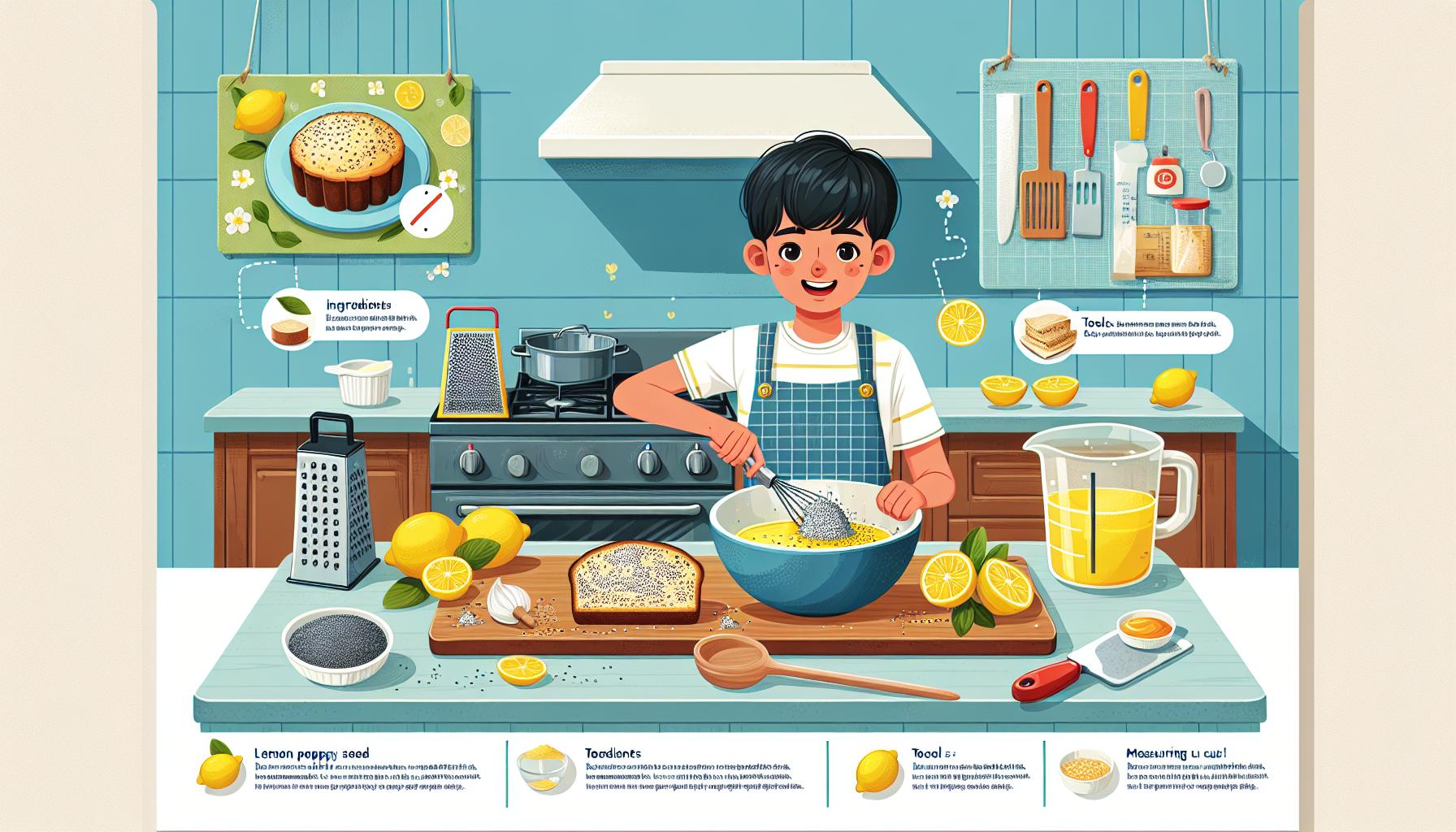
Spring brings the perfect opportunity to get kids excited about baking. As temperatures warm up and flowers bloom, we’ve found that children love learning kitchen skills while creating delicious seasonal treats. The magic of transforming simple ingredients into tasty creations sparks curiosity and builds confidence in young bakers.
Looking for ways to make baking more fun and educational for your little ones? Pre-measured ingredients and clear, illustrated instructions help kids stay focused on the joy of creating rather than getting overwhelmed by complex measurements. Whether they’re decorating cupcakes with spring flowers or rolling out cookie dough into fun shapes, these hands-on activities teach valuable skills while making precious memories. Plus, baking together offers a wonderful chance to bond, learn, and enjoy sweet rewards as a family.
Key Takeaways
- Spring baking with kids combines fun learning opportunities with hands-on kitchen skills development, making it an ideal family activity
- Simple recipes like no-bake rainbow cookies and butterfly cupcakes allow children to explore creativity while learning basic baking techniques
- Essential safety practices include proper hand washing, supervision near hot surfaces, and using child-appropriate tools
- Stock your kitchen with kid-friendly tools like measuring cups, non-slip bowls, and decorating supplies to make the experience more enjoyable
- Basic decorating techniques such as food coloring and simple piping methods help children develop fine motor skills while creating festive spring treats
Fun and Simple Spring Cookie Recipes
Spring cookies offer kids an exciting opportunity to explore festive shapes colors in the kitchen. These simple recipes encourage creativity while developing basic baking skills.
No-Bake Rainbow Cookies
No-bake rainbow cookies combine crushed vanilla wafers graham crackers with colorful sprinkles for a quick treat. Kids can mix butter cream cheese with powdered sugar to create the base then roll the mixture into small balls. Adding food coloring creates vibrant layers that mirror spring’s bright palette. The hands-on process of shaping rolling the cookies keeps young bakers engaged throughout the activity.
- Colorful sanding sugars for flower centers
- Piped buttercream petals
- Edible flower decorations
- Candy melts in spring colors
- Rainbow nonpareils for texture
| Cookie Type | Prep Time | Kid-Friendly Tasks |
|---|---|---|
| No-Bake Rainbow | 15 mins | Rolling mixing coloring |
| Flower Sugar | 25 mins | Cutting decorating frosting |
Colorful Cupcake Projects

Spring’s vibrant colors inspire creative cupcake decorating projects that excite young bakers. These simple yet engaging designs let kids explore their artistic side while practicing basic baking skills.
Butterfly Cupcakes
Transform regular cupcakes into delightful spring butterflies using simple ingredients. Cut each frosted cupcake in half, position the pieces as wings, and dust with powdered sugar for a magical effect. Kids can pipe colorful frosting patterns onto the wings using zip-top bags with the corners snipped. Add candy sprinkles, mini chocolate chips or edible pearls to create spots and patterns that make each butterfly unique.
Garden-Themed Decorating Ideas
Create an edible garden scene with nature-inspired cupcake decorations:
- Shape green frosting into grass using a multi-tip piping nozzle
- Place candy flowers made from M&Ms with pretzel stick stems
- Add gummy worms peeking out from chocolate cookie crumb “dirt”
- Craft mushrooms using white frosting dots topped with red fruit roll-up caps
- Design ladybugs using red fondant circles decorated with black spots
Kids can mix food coloring into vanilla frosting to achieve spring shades like:
| Base Color | Drops Needed | Result |
|---|---|---|
| White | 2-3 green | Grass |
| White | 1-2 pink | Flower petals |
| White | 2-3 yellow | Sunshine |
| White | 1 red + 1 yellow | Orange centers |
Each decoration technique builds fine motor skills while letting children express their creativity through edible art.
Easy Spring-Themed Quick Breads

Quick breads offer a perfect entry point for kids to experience baking success in springtime. These simple recipes require basic mixing skills and minimal equipment, making them ideal for young bakers.
Carrot Cake Muffins
These springtime muffins transform fresh carrots into moist, sweet treats kids love to make. Our recipe starts with grated carrots mixed with basic pantry ingredients like flour, eggs, oil and brown sugar. Kids can help measure dry ingredients, grate carrots (with supervision) and fold in raisins or chopped nuts. The muffins bake in 20 minutes at 350°F, creating an inviting aroma that builds excitement. Adding cream cheese frosting lets children practice their decorating skills using plastic bags with cut corners as simple piping tools.
Lemon Poppy Seed Loaf
This bright citrus loaf captures spring’s zesty flavors in an easy-to-follow recipe. Kids can help zest lemons, measure poppy seeds and mix the batter. The recipe uses:
| Ingredient | Amount |
|---|---|
| All-purpose flour | 2 cups |
| Fresh lemon zest | 2 tablespoons |
| Poppy seeds | 2 tablespoons |
| Butter | 1/2 cup |
| Sugar | 1 cup |
Children learn measuring skills while adding ingredients to create the tangy batter. The simple glaze combines lemon juice with powdered sugar, letting kids practice stirring and drizzling techniques. This loaf bakes for 45 minutes, teaching patience while filling the kitchen with citrus aromas that signal spring’s arrival.
Kitchen Safety Tips for Baking With Kids
Basic Kitchen Rules
Keep these essential safety practices in place while baking with children:
- Wash hands with soap and water for 20 seconds before touching ingredients
- Tie back long hair and roll up sleeves
- Use non-slip mats near sinks and workstations
- Keep paper towels within reach for quick cleanups
- Store cleaning products in a locked cabinet away from food items
Equipment Safety
Safe equipment handling prevents accidents:
- Place sharp tools like knives out of children’s reach
- Demonstrate proper oven mitt use for hot pans
- Use step stools with non-slip treads for better counter access
- Select child-sized tools appropriate for small hands
- Keep electrical cords away from water and hot surfaces
Temperature Guidelines
Monitor heat exposure with these practices:
| Item | Safe Temperature | Supervision Level |
|---|---|---|
| Oven | Below 350°F | Direct |
| Mixer | Low-Medium | Direct |
| Microwave | 30-second intervals | Direct |
| Refrigerator | 40°F or below | Minimal |
Ingredient Handling
Teach proper ingredient management:
- Read labels together to identify allergens
- Use separate tools for raw eggs
- Store perishables at correct temperatures
- Measure dry ingredients over a clean bowl
- Practice proper spoon and level techniques
Supervision Guidelines
Create a safe baking environment with these supervision tips:
- Stay within arm’s reach during active baking
- Guide knife work with hand-over-hand assistance
- Monitor hot surfaces closely
- Preview each step before starting
- Keep a first aid kit accessible in the kitchen
- Post emergency numbers by the phone
- Keep a fire extinguisher in an accessible spot
- Know the location of shut-off valves
- Stock basic first aid supplies
- Review basic safety procedures regularly
Essential Tools and Ingredients for Spring Baking
Basic Tools
The right tools make spring baking with kids safe and enjoyable. Here are the essential items for successful baking sessions:
- Measuring cups and spoons for accurate ingredient portions
- Non-slip mixing bowls in various sizes
- Silicone spatulas with easy-grip handles
- Child-safe mixing spoons and whisks
- Parchment paper for lining baking sheets
- Cookie cutters in spring shapes (flowers, butterflies)
- Cooling racks for fresh-baked treats
- Non-slip kitchen mats for stable footing
Must-Have Ingredients
Fresh spring baking starts with these pantry staples:
- All-purpose flour for consistent results
- Pure vanilla extract for natural flavor
- Unsalted butter at room temperature
- Large eggs for structure
- Granulated sugar for sweetness
- Powdered sugar for decorating
- Food coloring in spring pastels
- Sprinkles in seasonal shapes
Decorating Supplies
These items transform simple treats into spring masterpieces:
- Piping bags for frosting details
- Round and star-shaped decorating tips
- Food-safe paint brushes for details
- Edible markers for designs
- Candy melts in spring colors
- Gel food coloring for vibrant hues
- Cake boards for presentation
- Decorative cupcake liners
Storage Solutions
Keep baked goods fresh with these storage options:
- Airtight containers in multiple sizes
- Resealable plastic bags
- Glass jars with tight-fitting lids
- Cookie tins with dividers
- Cupcake carriers
- Plastic wrap for covering dough
- Labels for dating items
- Paper boxes for gifting treats
What spring treats do you plan to bake with your little ones? How might these tools help make the experience more enjoyable?
Kid-Friendly Decorating Techniques
Decorating spring treats gives kids the chance to express their creativity while developing fine motor skills. These simple techniques transform ordinary baked goods into festive spring masterpieces.
Working With Food Coloring
Food coloring adds vibrant spring hues to frostings buttercream decorations. Here’s how to help kids use food coloring effectively:
- Mix colors in small batches using gel food coloring for concentrated results
- Start with 1-2 drops then add more gradually to achieve desired shades
- Create pastel tones by adding tiny amounts of color to white frosting
- Use separate bowls spoons for each color to prevent mixing
- Keep paper towels handy for quick cleanup of stains
- Place protective covering on work surfaces before starting
Simple Piping Methods
Basic piping techniques let kids create professional-looking decorations with minimal tools:
- Fill disposable piping bags halfway to give kids better control
- Practice piping motions on wax paper before decorating treats
- Create grass using a multi-opening tip pointed straight up
- Make flowers with a star tip using gentle pressure circular motion
- Pipe dots rosettes with round tips by applying even pressure
- Use zip-top bags with corners snipped as beginner piping tools
- Hold the piping bag at a 90-degree angle for even results
- Keep steady consistent pressure while piping
- Practice basic shapes like swirls dots circles first
- Let kids experiment with different tips patterns
| Piping Tip Type | Best For Creating |
|---|---|
| Round (#3-5) | Dots writing outlines |
| Star (#16-21) | Flowers rosettes shells |
| Leaf (#352) | Leaves grass texture |
| Multi-opening | Grass fur texture |
Conclusion
Spring baking with kids is more than just creating delicious treats. It’s a chance to build confidence foster creativity and create lasting memories together. From colorful cupcakes to no-bake cookies these projects offer the perfect blend of fun and learning.
With the right tools safety measures and simple techniques we can transform our kitchens into spaces where young bakers thrive. By starting with basic recipes and gradually introducing new skills we’ll watch our little ones bloom alongside spring flowers into confident kitchen helpers.
So let’s grab our aprons gather our ingredients and embark on sweet springtime adventures with our young bakers. The memories we create will last far longer than any treat we bake!
Frequently Asked Questions
What age is appropriate to start baking with children?
Children can start baking as early as 2-3 years old with simple tasks like mixing and pouring pre-measured ingredients. By age 5-6, they can help measure ingredients and decorate treats. Always supervise children and adjust tasks according to their maturity level and motor skills.
How can I make baking safer for kids?
Establish clear safety rules: wash hands, tie back hair, use non-slip mats, and keep sharp tools away. Always supervise children, demonstrate proper oven mitt use, and keep a first aid kit nearby. Set up a designated workspace with child-safe utensils and ensure proper ingredient handling.
What are some easy spring-themed recipes for kids?
No-Bake Rainbow Cookies, Carrot Cake Muffins, and Butterfly Cupcakes are perfect for young bakers. These recipes require minimal equipment and feature simple mixing techniques. They also offer fun decorating opportunities that keep children engaged throughout the process.
How long should a baking session with kids last?
Keep baking sessions between 30-45 minutes for younger children and up to an hour for older kids. Choose recipes that match their attention span. No-bake recipes or quick breads are ideal for maintaining interest and achieving successful results.
What basic tools do I need for baking with kids?
Essential tools include child-safe measuring cups and spoons, non-slip mixing bowls, silicone spatulas, and decorating supplies like piping bags and food coloring. Invest in kid-sized aprons and oven mitts for safety and engagement.
How can I make baking educational for children?
Incorporate counting while measuring ingredients, discuss chemical reactions during mixing, and explore color theory when decorating. Use baking to teach patience, following instructions, and basic math skills. Encourage creativity through decorating and recipe modifications.
What are some spring-themed decorating ideas for baked goods?
Create edible grass using green-tinted coconut, make candy flowers with frosting, and design butterfly cupcakes using colorful sprinkles. Use pastel food coloring for spring-inspired treats and experiment with garden-themed decorations like gummy worms and ladybugs.
How do I store spring-baked treats?
Store baked goods in airtight containers at room temperature for up to 3 days. Use cupcake carriers for decorated items and separate layers with wax paper. Refrigerate treats with cream cheese frosting and consume within 5 days.

